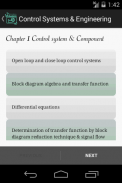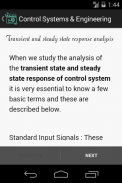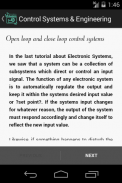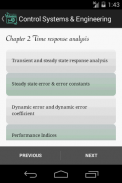






Control Systems & Engineering

Beschreibung von Control Systems & Engineering
It is swipe based designed for engineering students to learn control systems. It almost cover important topics with their graphics chapter wise which are given below
Chapter 1 Control system & Component
1. Open loop and close loop control systems
2. Block diagram algebra and transfer function
3. Differential equations
4. Determination of transfer function by block diagram reduction technique & signal flow graph method
5. Mason gain formula and calculation of transfer function
6. Basic component of electrical control system
7. Armature and field control methods for Speed control
Chapter 2 Time response analysis
1. Transient and steady state response analysis
2. Steady state error & error constants
3. Dynamic error and dynamic error coefficient
4. Performance Indices
5. Effects of pole and zero addition on transient
Chapter 3 stability analysis
1. Stability Theory
2. ABSOLUTE STABILITY
3. Root locus method of analysis
4. Polar plots
Chapter 4 Approaches to system design
1. Design problem
2. types of compensation
3. design of phase-lag
4. proportional
5. integral and PID compensation
Chapter 5 Digital control systems
1. System with digital controller
2. difference equations
3. the z-transform
4. pulse transfer function
5. inverse ztransform
6. the s and z domain relationship
</div> <div jsname="WJz9Hc" style="display:none">Es wird Swipe für Ingenieurstudenten based entwickelt, um Steuerungssysteme zu lernen. Es fast decken wichtige Themen mit ihren Grafiken Kapitel weise, die unten angegeben sind
Kapitel 1 Steuerungssystem und Baustein-
1. Öffnen Sie Schleife und in der Nähe Regelsysteme
2. Blockschaltalgebra und Übertragungsfunktion
3. Differentialgleichungen
4. Bestimmung der Übertragungsfunktion von Blockschaltreduktionstechnik und Signalflussdiagramm-Methode
5. Mason Verstärkungsformel und Berechnung der Übertragungsfunktion
6. Grundkomponente des elektrischen Steuersystems
7. Der Anker und Feldsteuerungsverfahren zur Geschwindigkeitssteuerung
Kapitel 2 Zeitverhalten-Analyse
1. stationären und instationären Reaktionsanalyse
2. Stationäre Fehler & Fehlerkonstanten
3. Dynamische Fehler und dynamische Fehlerkoeffizient
4. Performance Indices
5. Auswirkungen der Pol- und Null hinaus auf transiente
Kapitel 3 Stabilitätsanalyse
1. Stabilität Theory
2. absolute Stabilität
3. Wurzelortsanalysemethode
4. Polar Plots
Kapitel 4 Zugänge zum System-Design
1. Design Problem
2. Arten von Kompensations
3. Ausführung der Phasenverzögerung
4. proportional
5. integraler und PID-Kompensation
Teil 5 Digitale Steuerungssysteme
1. System mit digitaler Steuerung
2. Differenzengleichungen
3. die z-Transformation
4. Impulsübertragungsfunktion
5. inverse ztransform
6. die s und z-Domäne Beziehung</div> <div class="show-more-end">


























